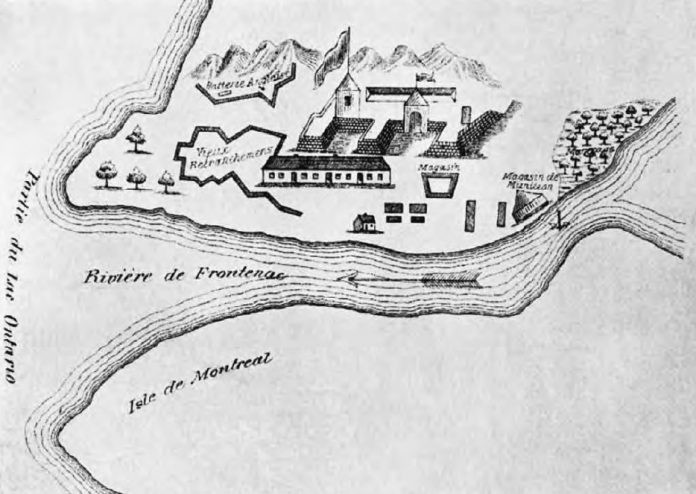The French garrison was founded on July 12, 1673, named for Quebec’s celebrated 17th-century governor, Louis de Baude de Frontenac. Fort Frontenac was cited on the northeastern shore of Lake Ontario and abutted the Cataraqui River near present-day Kingston, Ontario.
It initially consisted of several small buildings surrounded by a wooden palisade. Construction at the time was feasible only because the English were engaged overseas and the Iroquois perennial enemies of the French were tied up fighting the Susquehannocks and the Mohegans. The fort started to evolve into a factual stronghold in 1675, after the French Crown appointed explorer René-Robert Cavelier, Sieur de La Salle, its commanding officer.

By 1677, La Salle had converted the fort into an imposing, square-shaped structure, with stone walls 3 feet thick, 15 feet high, and 300 feet long, complemented by 30 cannons and bastions at each corner. First, the major European colonial outposts on the lower Great Lakes Fort Frontenac also allowed for the construction and harborage of an armed fleet, giving the French early naval supremacy on these strategically vital inland waters.
During the latter stages of the Beaver Wars (1641–1701) against the Iroquois and during the overlapping conflict with the British known as King William’s War (1689–1697), Fort Frontenac proved to be both an asset and a liability to the French. On the one hand, it was an extremely valuable support base for military expeditions deep into Iroquois territory.
It had, after all, been King Louis XIV’s 1665 edict demanding the “extermination” of the Iroquois that inspired the construction of the fort in the first place. The resulting scorched-earth campaigns against Confederacy nations such as the Senecas in 1687 and the Onondagas and Oneidas in 1697 were all launched from Fort Frontenac and were a key reason France was able to secure an advantageous peace with the Iroquois in 1701.
Furthermore, the fort commanded the main route leading from the Iroquois homeland south of Lake Ontario to the Ottawa tribal territory in the north, impeding a potential alliance between these two groups, the forging of which would have diverted thousands of Canadian furs from Montreal to Albany. Yet during this same period, Fort Frontenac’s disadvantages were also glaringly apparent.
It was so susceptible to assault by land that the Iroquois were able to keep it under continual siege from 1687 to 1688, causing scurvy and other maladies to spread among the fort’s occupants. The supply line from Montreal to the Cataraqui was also extremely vulnerable and unreliable, entailing as it did numerous portages from where ambushes could easily be sprung.
By 1689, the drain of this on military staff and objects, coupled with the brutal Iroquois attack on Lachine on July 25–26, 1689, enforced the French to raze Fort Frontenac and withdraw the garrison. However, rebuilt and reoccupied by 1697, Fort Frontenac soon became far more significant as a trading center and symbol of French sovereignty than as a military outpost.
Although Louis XIV had formerly discouraged fort building and western expansion for fear of spreading his colony too thin, the imperial rivalry with Britain that started in earnest with the onset of Queen Anne’s War (1702–1713) forced a reverse this policy. Thus instead of being seen as a drain on the population of New France, Fort Frontenac and similar outposts were now treated as de facto villages.
During this era, Fort Frontenac (Ontario) Louis XIV went from punishing coureurs de bois as traitors to considering them as manifest extensions of French power in North America. It is no chance that these Canadian fur traders increasingly started carrying government licenses and were granted the more respectable title of the voyageur. French territorial expansion combined with the fur trade made outposts such as Fort Frontenac economically self-sustaining and even profitable.
And in their role as the king’s posts, they cemented native alliances while checking British commercial and territorial ambitions. The next major action involving Fort Frontenac came during the French and Indian War (1754–1763), in which it figured prominently in the strategies of both the French and English. Fort Frontenac and its nemesis straightforwardly across the lake, Fort Oswego (started by the British in 1724), would be key staging areas during the war and would wind up facilitating each other’s destruction.
In 1756, French major general Louis-Joseph, Marquis de Montcalm, attacked from Fort Frontenac with 3,000 men and completely pillaged all of Oswego’s fortifications. Two years later, on August 25, 1758, Lieutenant Colonel John Bradstreet mustered a force on the ashes of Britain’s erstwhile stronghold and repaid the French by leading a successful amphibious assault against Fort Frontenac.
By August 28, Bradstreet had forced the capitulation of the commandant, Pierre-Jacques Payen de Noyan, and burned the ships anchored in the fort’s harbor, thus extinguishing the French naval presence on the Great Lakes. Even more significantly, perhaps, the subsequent razing of Fort Frontenac destroyed a huge stockpile of supplies destined for Fort Duquesne, paving the way for British follow-up attacks that put French Canada on the defensive for the duration of the war.
After Bradstreet’s incursion, Fort Frontenac would remain in ruins for the remainder of the colonial period, and would not see occupation again until the 1780s, when Loyalists fleeing the American Revolutionary War settled among its remains and built on it the future capital of a united Canada.
Read More – Treaty of Paris 1763








